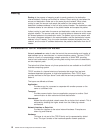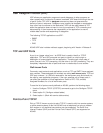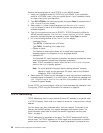
User Datagram Protocol (UDP)
UDP allows your application programs to send datagrams to other programs on
other systems with a minimum of protocol overhead. UDP does this through the use
of ports. Unlike TCP, UDP is datagram oriented and does not guarantee the
delivery of data in sequence. Datagrams may possibly be dropped or reordered as
they travel from the source to the destination. UDP can be used instead of TCP
when the application does not want to incur the overhead of TCP connecting and
disconnecting. It then becomes the responsibility of the application to ensure
reliable data transfer and sequencing of datagrams.
The following TCP/IP applications use UDP:
v SNMP
v TFTP
v DNS
AS/400 UDP also includes multicast support, beginning with Version 4 Release 2.
TCP and UDP Ports
A port is an integer value from 1 to 65535 that is used to identify a TCP/IP
application. TCP and UDP protocols use ports to identify a unique origin or
destination of communication with an application. There are two unique sets of
ports. One set is for TCP processing, and the other is for UDP processing. They are
completely independent sets of ports and have no relationship to one another.
Well-known Ports
Commonly used protocols and applications, such as FTP and SMTP, have assigned
port numbers. These assigned port numbers are called well-known ports. TCP and
UDP port numbers 1 to 1023 are reserved for the well-known ports and should not
be used by user application programs. If the user specifies one of these ports, it
can affect the operation of those applications. Refer to RFC 1700, entitled,
Assigned Numbers
, for a list of well-known ports.
To see the list of ports currently defined on AS/400, perform the following steps:
1. Use the Configure TCP/IP (CFGTCP) command to get to the Configure TCP/IP
menu
2. Select option 21 (Configure related tables)
3. Select option 1 (Work with service table entries)
Point-to-Point TCP/IP
Dial-up TCP/IP, known as point-to-point TCP/IP, is used to dial into remote systems,
or allow remote systems to dial into AS/400 over a telephone line using a modem.
Null modem or non-switched connections are also supported. The Serial Line
Internet Protocol (SLIP) and the Point-to-Point Protocol (PPP) are supported on
AS/400.
Chapter 1. TCP/IP on AS/400 17


















